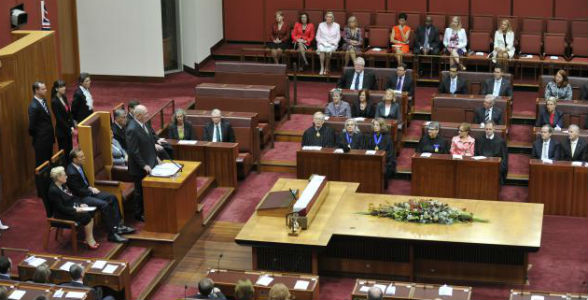The development of semi-parliamentarism in Australia
Steffen Ganghof has described the Australian system at both national and state levels as ‘semi-parliamentarian’ since governments do not need to maintain the confidence of the upper chambers to survive. Rodney Smith traces how Australia’s upper houses have evolved and established distinct, strengthened mechanisms of executive scrutiny.

Senate Chamber, Australia. Picture: Office of the Official Secretary to the Governor-General, Australia, via a CC BY 3.0 licence
One thing that struck me recently when I was re-reading Labor Party minister Fred Daly’s memoirs From Curtin to Kerr (1977) was his view that the Senate was essentially irrelevant to day-to-day Australian politics. Daly’s working assumption about the Senate was shared by most of Prime Minister Gough Whitlam’s other ministers and helped to undo the Labor government in November 1975.
No political scientist researching Australian politics today would make the same assumption about the Senate and its equivalent state upper houses; however, few political scientists would view Australia’s system of government as anything other than a parliamentary system. Now Steffen Ganghof, along with his colleagues Sebastian Eppner and Alexander Pörschke, has advanced the slightly confronting proposition that Australia’s upper houses, conceived in the nineteenth century as conservative legislative buffers, have evolved to help create a new form of ‘semi-parliamentary’ government in Australia.
When did this evolution occur? By Ganghof’s definition, Australian colonial governments were parliamentary rather than semi-parliamentary. The colonial parliaments were all bicameral and executives needed only the confidence of the directly elected lower houses to survive. Crucially, while the upper houses were powerful, none of them was elected using an inclusive franchise. The Commonwealth government thus has the best claim to be Australia’s first semi-parliamentary system, since the elected Senate was given virtually identical powers to the House of Representatives in 1901. The Senate’s shift to a Hare-Clark (Single Transferable Vote) election system in 1949 laid the foundation for strengthening this semi-parliamentarism. Queensland remained a parliamentary system by abolishing its upper house in 1921, while the introduction of inclusive franchises for upper houses meant that the other states moved from parliamentary to semi-parliamentary systems between 1950 and 1978. The ACT and Northern Territory both adopted the unicameral parliamentary model.
Ganghof (2017: 4-6) suggests that New South Wales (NSW) comes the ‘closest’ to ‘ideal type … semi-parliamentarism’ of any political system in Australia and indeed the world. The relevant differences between NSW and the other Australian jurisdictions can, however, be overstated. It is true, for example, that NSW lacks the joint sitting mechanism present in other bicameral states and the Commonwealth that ultimately allows governments in those jurisdictions to pass legislation despite resistance by hostile upper houses. At the same time, there is a constitutional path by which NSW governments can pursue the passage of deadlocked legislation to a successful conclusion. It may be a long and arduous path but it does exist.
We might ask whether the identification of NSW and other Australian jurisdictions as ‘semi-parliamentary’ really matters. One argument for saying that it does can be found in the difference between Fred Daly’s 1970s view of the Senate and the attitude of most Labor politicians today. Labor’s calls for the abolition of upper houses have largely died out and, at least in Opposition, Labor has enthusiastically used the powers of upper houses to pursue its goals. The conventions regarding upper houses and executives that have evolved since the 1980s at Commonwealth and state level reflect semi-parliamentary expectations. Governments mostly do not control upper houses and must therefore negotiate the passage of bills with Oppositions or minor parties. Upper houses have strengthened or revived mechanisms of executive scrutiny, including committee systems, the censure of ministers, disallowance of regulations and motions for the production of government papers. By the same token, confidence in the executive as a whole is seen as the prerogative of lower houses. The politicians involved may not think to call this semi-parliamentarism but their politics operates according to semi-parliamentary rules and norms.
This article represents the views of the author and not those of Democratic Audit. It was originally published on Pop Politics Aus and it draws on the journal article: ‘New South Wales: an accidental case of semi-parliamentarism?’, published in Australian Journal of Political Science
About the author
 Rodney Smith is Professor of Australian Politics at the University of Sydney.
Rodney Smith is Professor of Australian Politics at the University of Sydney.





 Democratic Audit's core funding is provided by the Joseph Rowntree Charitable Trust. Additional funding is provided by the London School of Economics.
Democratic Audit's core funding is provided by the Joseph Rowntree Charitable Trust. Additional funding is provided by the London School of Economics.
[…] Rodney Smith has argued recently on this blog, it wasn’t until the voting system for the Senate changed in the late 1940s that the full […]